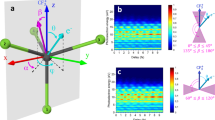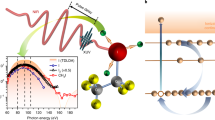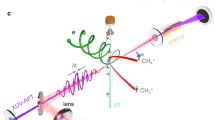Abstract
Photoionization as a half-scattering process is not instantaneous. Usually, time delays in photoionization are on the order of tens of attoseconds. In going from a single atom to a nano-object, one can expect the delay to increase, since the photoelectron scatters over a larger distance. Here we show that this intuition is not correct when comparing three-dimensional and planar molecules. Using attosecond interferometry, we find that the time delays in two-dimensional (2D) carbon-based molecules can be significantly shorter than those of three-dimensional counterparts. The measured time delay carries the signature of the spatial distribution of the 2D hole created in the residual molecular cation, allowing us to obtain its dimensions with angstrom accuracy. Our results demonstrate that the photoionization delay depends on the symmetry and shape of the created hole, as we show by identifying a quadrupole contribution in the measured delay of 2D molecules.
This is a preview of subscription content, access via your institution
Access options
Access Nature and 54 other Nature Portfolio journals
Get Nature+, our best-value online-access subscription
$29.99 / 30 days
cancel any time
Subscribe to this journal
Receive 12 print issues and online access
$209.00 per year
only $17.42 per issue
Buy this article
- Purchase on Springer Link
- Instant access to full article PDF
Prices may be subject to local taxes which are calculated during checkout




Similar content being viewed by others
Data availability
All the data necessary to validate the results are included in the main text and Supplementary Information. Additional data are available upon reasonable request to V.L. or F.L. Source data are provided with this paper.
References
Hawkes, P. W. & Spence, J. C. H. Science of Microscopy (Springer, 2007).
Becker, U. & Shirley, D. A. VUV and Soft X-Ray Photoionization (Plenum, 1996).
Krausz, F. & Ivanov, M. Attosecond physics. Rev. Mod. Phys. 81, 163–234 (2009).
Lépine, F., Ivanov, M. Y. & Vrakking, M. J. J. Attosecond molecular dynamics: fact or fiction? Nat. Photonics 8, 195–204 (2014).
Pazourek, R., Nagele, S. & Burgdörfer, J. Attosecond chronoscopy of photoemission. Rev. Mod. Phys. 87, 765–802 (2015).
Wigner, E. P. Lower limit for the energy derivative of the scattering phase shift. Phys. Rev. 98, 145–147 (1955).
Schultze, M. et al. Delay in photoemission. Science 328, 1658–1662 (2010).
Klünder, K. et al. Probing single-photon ionization on the attosecond time scale. Phys. Rev. Lett. 106, 143002 (2011).
Isinger, M. et al. Photoionization in the time and frequency domain. Science 358, 893–896 (2017).
Huppert, M., Jordan, I., Baykusheva, D., von Conta, A. & Wörner, H. J. Attosecond delays in molecular photoionization. Phys. Rev. Lett. 117, 093001 (2016).
Vos, J. et al. Orientation-dependent stereo wigner time delay and electron localization in a small molecule. Science 360, 1326–1330 (2018).
Biswas, S. et al. Probing molecular environment through photoemission delays. Nat. Phys. 16, 778–783 (2020).
Loriot, V. et al. High harmonic generation-2ω attosecond stereo-photoionization interferometry in N2. J. Phys. Photonics 2, 024003 (2020).
Nandi, S. et al. Attosecond timing of electron emission from a molecular shape resonance. Sci. Adv. 6, eaba7762 (2020).
Gong, X. et al. Attosecond spectroscopy of size-resolved water clusters. Nature 609, 507–511 (2022).
Seiffert, L. et al. Attosecond chronoscopy of electron scattering in dielectric nanoparticles. Nat. Phys. 13, 766–770 (2017).
Ossiander, M. et al. Absolute timing of the photoelectric effect. Nature 561, 374–377 (2018).
Jordan, I. et al. Attosecond spectroscopy of liquid water. Science 369, 974–979 (2020).
Paul, P. M. et al. Observation of a train of attosecond pulses from high harmonic generation. Science 292, 1689–1692 (2001).
Mairesse, Y. et al. Attosecond synchronization of high-harmonic soft x-rays. Science 302, 1540–1543 (2003).
Dahlström, J. M. et al. Theory of attosecond delays in laser-assisted photoionization. Chem. Phys. 414, 53–64 (2013).
Linstrom, P. & Mallard, W. The NIST chemistry webbook: a chemical data resource on the internet. J. Chem. Eng. Data 46, 1059 (2001).
Mauritsson, J., Gaarde, M. B. & Schafer, K. J. Accessing properties of electron wave packets generated by attosecond pulse trains through time-dependent calculations. Phys. Rev. A 72, 013401 (2005).
Kotur, M. et al. Spectral phase measurement of a Fano resonance using tunable attosecond pulses. Nat. Commun. 7, 10566 (2016).
Hervé, M. et al. Ultrafast dynamics of correlation bands following XUV molecular photoionization. Nat. Phys. 17, 327–331 (2021).
Tao, Z. et al. Direct time-domain observation of attosecond final-state lifetimes in photoemission from solids. Science 353, 62 (2016).
Siek, F. et al. Angular momentum-induced delays in solid-state photoemission enhanced by intra-atomic interactions. Science 357, 1274 (2017).
Garg, M. et al. Real-space subfemtosecond imaging of quantum electronic coherences in molecules. Nature Photonics 16, 196–202 (2022).
Eppink, A. T. J. B. & Parker, D. H. Velocity map imaging of ions and electrons using electrostatic lenses: Application in photoelectron and photofragment ion imaging of molecular oxygen. Rev. Sci. Instrum. 68, 3477–3484 (1997).
Stener, M., De Alti, G. & Decleva, P. Convergence of the density functional one-centre expansion for the molecular continuum: N2 and (CH3)3N. Theor. Chem. Acc. 101, 247–256 (1999).
Toffoli, D., Stener, M., Fronzoni, G. & Decleva, P. Convergence of the multicenter B-spline DFT approach for the continuum. Chem. Phys. 276, 25–43 (2002).
Nisoli, M., Decleva, P., Calegari, F., Palacios, A. & Martín, F. Attosecond electron dynamics in molecules. Chem. Rev. 117, 10760–10825 (2017).
Baykusheva, D. & Wörner, H. J. Theory of attosecond delays in molecular photoionization. J. Chem. Phys. 146, 124306 (2017).
Smith, F. T. Lifetime matrix in collision theory. Phys. Rev. 118, 349–356 (1960).
Stener, M., Toffoli, D., Fronzoni, G. & Decleva, P. Recent advances in molecular photoionization by density functional theory based approaches. Theor. Chem. Acc. 117, 943–956 (2007).
van Leeuwen, R. & Baerends, E. J. Exchange-correlation potential with correct asymptotic behavior. Phys. Rev. A 49, 2421–2431 (1994).
Acknowledgements
We thank M. Hervé, E. Constant and G. Karras for fruitful discussions. All calculations were performed at the Centro de Computación Científica (CCC) of the Universidad Autónoma de Madrid and the MareNostrum supercomputer of the Red Española de Supercomputación. We acknowledge support from CNRS, ANR-16-CE30-0012 ‘Circé’, ANR-15-CE30-0001 ‘CIMBAAD’, the Fédération de recherche André Marie Ampère and the European COST Action AttoChem (CA18222). C.M.G.C., E.P., A.P. and F.M. are supported by the Ministerio de Ciencia e Innovación (MICINN) project PID2019-105458RB-I00 and the Comunidad de Madrid project FULMATEN (ref. Y2018NMT-5028). F.M. acknowledges support from the ‘Severo Ochoa’ Programme for Centres of Excellence in R&D (CEX2020-001039-S) and the ‘Maria de Maeztu’ Programme for Units of Excellence in R&D (CEX2018-000805-M).
Author information
Authors and Affiliations
Contributions
V.L. and F.L. conceived the project. A.B., A.M., C.L.G., Y.H., S.N., F.L., and V.L. performed the experiment. V.L. analysed the data. S.N. developed the analytical model. C.M.G.-C., M.L.-.A. and E.P. performed the theoretical calculations under the supervision of A.P., P.D., and F.M. The manuscript is written by V.L., S.N., and F.L. with inputs from all the authors. V.L., F.M., and F.L. supervised the project.
Corresponding authors
Ethics declarations
Competing interests
The authors declare no competing interests.
Peer review
Peer review information
Nature Physics thanks the anonymous reviewers for their contribution to the peer review of this work.
Additional information
Publisher’s note Springer Nature remains neutral with regard to jurisdictional claims in published maps and institutional affiliations.
Extended data
Extended Data Fig. 1 Continuum-continuum contribution.
(a) Theoretical continuum-continuum delay τcc from Ref. [21] as a function of the photoelectron energy (solid line). (b) τcc correction for naphthalene (purple), fluorene (fuchsia) and pyrene (fuchsia) calculated from (a) considering the differences in the ionization potentials compared to adamantane.
Extended Data Fig. 2 Experimental two-photon delays.
The experimental values for (a-d) naphthalene and (e-h) adamantane for sidebands SB14, SB16, SB18 and SB20 respectively.
Extended Data Fig. 3 Experimental setup.
The two main components of the setup: a Mach-Zehnder interferometer and a velocity map imaging spectrometer (VMIS). See methods for details.
Extended Data Fig. 4 SE-DFT calculation for as a function of the basis size.
(a,c) photoabsorption cross-section and (b,d) their corresponding Wigner time delay for (a-b) naphthalene and (c-d) adamantane, respectively as a function of the basis size.
Supplementary information
Supplementary Information
1, Analytical model. 2, Relative temporal calibration, Fig. SI1 and Fig. SI2. 3, Angle-resolved photoionization time delay, Fig. SI3. 4, Deconvolution of the states, Fig. SI4.
Source data
Source Data Fig. 1
Transients of Fig. 1b,c.
Source Data Fig. 2
Experimental, model and SE-DFT values of Fig. 2a,c,d.
Source Data Fig. 3
Experimental, model and SE-DFT values of Fig. 3.
Source Data Fig. 4
Experimental, model and SE-DFT values of Fig. 4a and SE-DFT values of Fig. 4b.
Rights and permissions
Springer Nature or its licensor (e.g. a society or other partner) holds exclusive rights to this article under a publishing agreement with the author(s) or other rightsholder(s); author self-archiving of the accepted manuscript version of this article is solely governed by the terms of such publishing agreement and applicable law.
About this article
Cite this article
Loriot, V., Boyer, A., Nandi, S. et al. Attosecond metrology of the two-dimensional charge distribution in molecules. Nat. Phys. (2024). https://doi.org/10.1038/s41567-024-02406-2
Received:
Accepted:
Published:
DOI: https://doi.org/10.1038/s41567-024-02406-2



